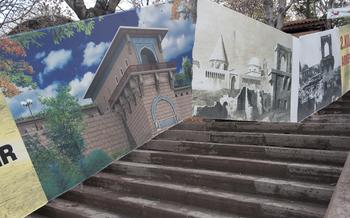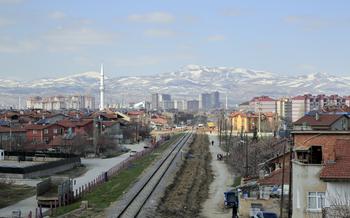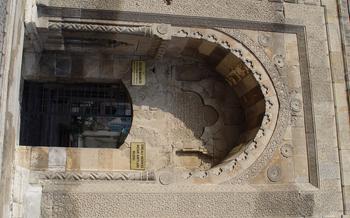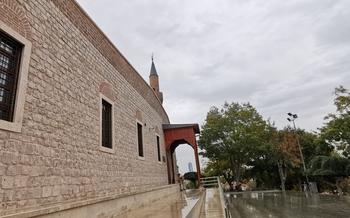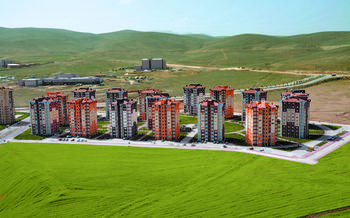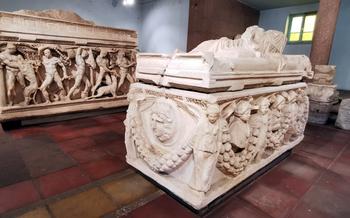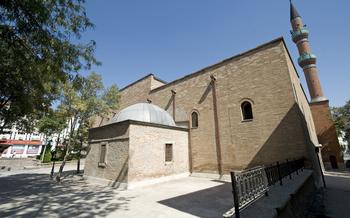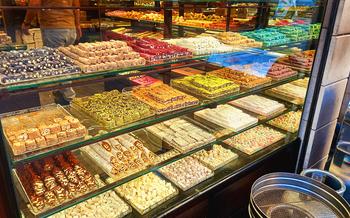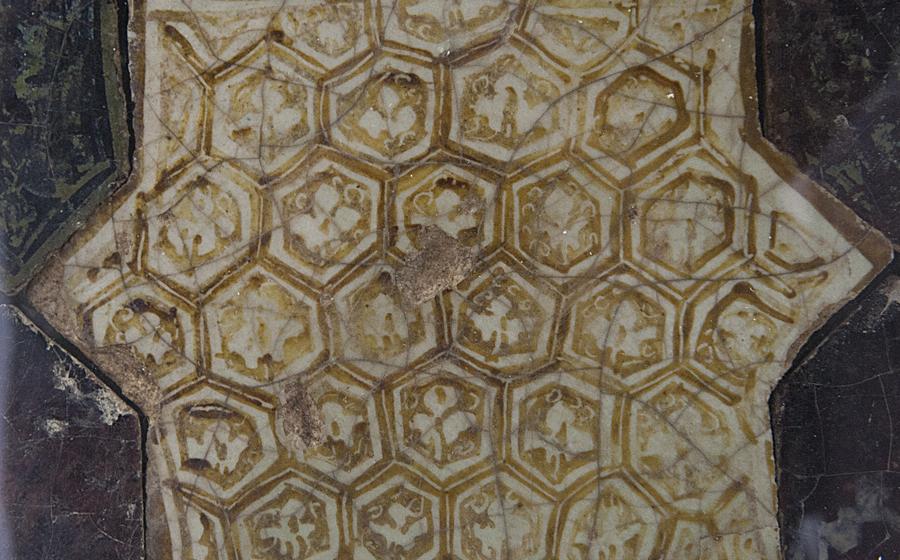
Kubadabad Palace
- Historical Significance
- Architectural Marvels
- Throne Room Grandeur
- Sultan's Bathhouse Rituals
- Royal Gardens Serenity
- Interactive Exhibitions
- Guided Tours Insights
- Spectacular Photo Opportunities
- Authentic Turkish Cuisine
- Souvenir Shopping Delights
- Konya's Cultural Legacy
- Getting There and Around
- Insider Tip:
Historical Significance
Step into the annals of history as you explore the Kubadabad Palace, a testament to the grandeur of the Seljuk Empire. Built in the 13th century by Sultan Kayqubad I, this architectural marvel served as the administrative center of the empire, radiating power and prestige. Discover the palace's rich tapestry of influences, blending Seljuk, Byzantine, and Persian elements into a harmonious masterpiece. Though time took its toll, leaving the palace in ruins, its rediscovery and restoration in the 20th century breathed new life into its majestic walls, inviting visitors to unravel its captivating story.
Architectural Marvels
The Kubadabad Palace is a testament to the architectural prowess of the Seljuk era. Admire the intricate stone carvings that adorn the palace's exterior, depicting scenes from history and mythology. The main entrance gate, with its imposing arch and decorative tilework, sets the tone for the grandeur that awaits inside. Explore the vast courtyard, surrounded by elegant arcades and chambers, each with its unique architectural features. Marvel at the impressive central dome, supported by four massive pillars, which dominates the palace's interior. The innovative construction techniques and materials used in the palace's construction, such as the use of vaulted ceilings and lightweight bricks, showcase the advanced engineering skills of the Seljuk era.
Throne Room Grandeur
Step inside the magnificent throne room, the centerpiece of the palace, where the Seljuk sultans held court and received guests. Imagine the grandeur and opulence of the throne room, decorated with intricate tilework, paintings, and luxurious furnishings. Admire the elevated platform, where the sultan's throne would have been placed, symbolizing his authority and power. Feel the awe-inspiring atmosphere of this grand hall, where important decisions were made and the fate of the empire was shaped.
Sultan's Bathhouse Rituals
Step into the sultan's private bathhouse, an essential part of Seljuk palace life and a symbol of cleanliness and purification. Explore the various chambers of the bathhouse, including the dressing room, the hot room, and the cold room, each serving a specific purpose. Discover the bathing rituals and customs practiced by the sultan and his entourage, including massages, steam treatments, and relaxation techniques. Imagine the soothing and rejuvenating experience of bathing in the sultan's luxurious bathhouse, surrounded by beautiful tiles and intricate carvings.
Royal Gardens Serenity
Stroll through the serene and beautifully landscaped royal gardens that surround the Kubadabad Palace. Admire the lush greenery, colorful flowers, and fragrant trees that create a tranquil oasis in the midst of the palace complex. Imagine the sultan and his guests relaxing and enjoying the tranquility of the gardens, away from the hustle and bustle of court life. Discover the symbolism and significance of the various plants and flowers in the gardens, representing power, beauty, and harmony.
Interactive Exhibitions
Engage with the history of the Kubadabad Palace through interactive exhibitions and displays that bring the past to life. Experience virtual reality tours that transport you back to the 13th century, allowing you to explore the palace in its original splendor. Participate in hands-on activities and workshops that provide a deeper understanding of Seljuk art, architecture, and customs. Test your knowledge of the palace and the Seljuk era through interactive games and quizzes. These immersive experiences offer a fun and educational way to learn about the rich history and cultural significance of the Kubadabad Palace.
Guided Tours Insights
To truly immerse yourself in the history and significance of the Kubadabad Palace, consider embarking on a guided tour. Knowledgeable guides will lead you through the palace's various chambers, courtyards, and gardens, sharing fascinating stories and anecdotes about its former inhabitants and their lavish lifestyle. They will point out architectural details, explain the palace's role in Seljuk history, and answer any questions you may have. With a guided tour, you'll gain a deeper understanding and appreciation for this remarkable historical site. Choose from general tours that provide a comprehensive overview of the palace to themed tours that focus on specific aspects of its history or architecture. Private tours are also available for a more personalized experience tailored to your interests.
Spectacular Photo Opportunities
The Kubadabad Palace is a photographer's paradise, with endless opportunities to capture stunning images of its impressive architecture, intricate details, and serene gardens. Explore the palace's various vantage points to find the perfect angles for your shots. Take advantage of the natural light at different times of the day to create dramatic and beautiful images. Share your photos on social media to inspire others to visit this hidden gem of Turkish history. From the grand entrance gate to the hidden corners of the harem, every nook and cranny of the palace is a potential masterpiece waiting to be captured.
Authentic Turkish Cuisine
Indulge in the delicious flavors of traditional Turkish cuisine at one of the many restaurants located near the Kubadabad Palace. Sample regional specialties such as Konya's famous "etli ekmek" (meat-filled flatbread), "tantuni" (grilled meat wrap), and "mevlana şerbeti" (a sweet beverage flavored with rosewater). Experience the warm hospitality and friendly service that are hallmarks of Turkish restaurants. Enjoy your meal in a charming ambiance that reflects the rich cultural heritage of Konya.
Souvenir Shopping Delights
Indulge in the vibrant shopping scene near the Kubadabad Palace and discover a treasure trove of unique souvenirs and handicrafts. Browse through an array of traditional Turkish carpets, each a masterpiece of intricate weaving and vibrant colors. Admire the delicate pottery, adorned with intricate patterns and motifs that tell stories of Turkish culture. Explore the shimmering jewelry, handcrafted with precision and adorned with precious stones that capture the essence of the region's artistry. Delve into the world of Turkish textiles, from soft and luxurious pashminas to intricately embroidered fabrics that showcase the region's rich textile heritage. Support local artisans by purchasing handmade souvenirs, each imbued with the spirit of Konya's vibrant cultural traditions. Experience the art of bargaining and negotiation, a cherished part of the Turkish shopping experience, to secure the best prices for your treasured finds.
Konya's Cultural Legacy
Konya, the city where the Kubadabad Palace stands, is a treasure trove of cultural and historical wonders. Beyond the palace walls, visitors can delve deeper into Konya's rich heritage by exploring its other historic sites, museums, and cultural institutions.
The Mevlana Museum, a must-visit destination, is dedicated to the life and teachings of the renowned Sufi mystic Rumi, whose influence on Turkish culture and thought cannot be overstated. Here, visitors can learn about Rumi's philosophy of love and tolerance, and admire his exquisite poetry and calligraphy.
Another architectural masterpiece not to be missed is the Selimiye Mosque, a magnificent example of Ottoman architecture. With its soaring dome and intricate tilework, the Selimiye Mosque is a testament to the artistic and spiritual achievements of the Ottoman era.
Konya's vibrant cultural heritage comes alive during the annual Konya Culture and Art Festival, held in May. This month-long festival showcases traditional music, dance, and handicrafts, providing visitors with an immersive experience of Konya's rich cultural traditions.
Whether you're interested in history, architecture, or the arts, Konya offers a wealth of experiences that will captivate and inspire. Discover the city's unique blend of Seljuk, Ottoman, and modern influences, and gain a deeper understanding of the cultural tapestry that makes Konya so special.
Getting There and Around
Konya is conveniently accessible by air, with direct flights from major cities across Turkey and Europe. Once you arrive at Konya Airport, you can take a taxi or rent a car to reach the Kubadabad Palace, which is situated approximately 10 kilometers from the city center. The journey takes about 20 minutes by car. Konya also boasts an efficient public transportation system, with buses that stop near the palace, providing a budget-friendly option for getting around. Plan your visit during the shoulder seasons (spring or fall) to avoid the summer crowds and sweltering heat.
Insider Tip:
For an unforgettable and serene experience, plan your visit to the Kubadabad Palace early in the morning or late in the afternoon, when the crowds are fewer. This will allow you to soak in the palace's grandeur and tranquility without distractions. Remember to wear comfortable shoes, as exploring the palace and its sprawling gardens involves a fair amount of walking. Konya's weather can be extreme, with scorching summers and chilly winters, so dress accordingly. In the summer, bring sunscreen and a hat to protect yourself from the sun's intensity. In the winter, bundle up in warm clothing to stay cozy. By following these tips, you'll make the most of your visit to this hidden gem of Turkish history.

